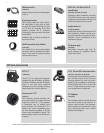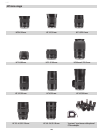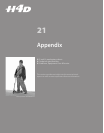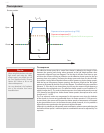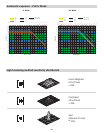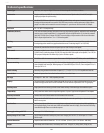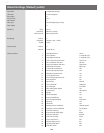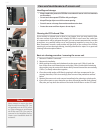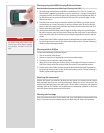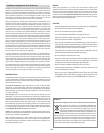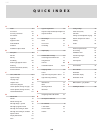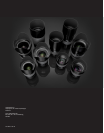
137
H4D
Problems, Equipment Care & Service
The H4D is a very sophisticated camera that relies on much information being
passed and processed to and from each modular unit to produce the correct
behavior. It is therefore essential that reasonable care is taken in attaching,
detaching and storing the viewnder, lenses, extension tubes, etc to ensure
that the databus connections are not damaged or soiled in any way. Also
when lifting or handling the camera try to always use the grip or strap and
avoid holding the camera just by the sensor unit or viewnder.
Warning messages are normally easily addressed and remedied but ‘Error’
messages require further attention as they denote a fault, temporary or
otherwise. You should methodically investigate the situation to see for ex-
ample whether the recent attachment of an accessory has coincided with
the appearance of an error message. Standard procedure is to detach and
re-attach the viewnder, lens etc ensuring that they are positioned rmly
and correctly to see whether the problem disappears. Failing that, removal
of the battery grip for about ten seconds or so will reset the camera’s proces-
sors. Persistent error messages might well signify a more complex problem
and you are advised to contact your nearest Hasselblad Authorized Service
Center for advice. You may receive a feedback report on either the grip dis-
play or the capture unit display. Please note this message carefully as it can
facilitate support response greatly, as well as improve on rmware updates .
As well as the error message, a description of the camera’s behavior and an
account of what action you were trying to take when it happened could be
also benecial. Also, please remember that if a hardware check is to be made,
the Center will almost certainly want to inspect all of the items that were
involved when the error message rst appeared.
In certain situations, it is possible that the camera can be aected by a
discharge of static electricity particularly if the area around the control but-
tons on the grip comes into contact with a conductive cord or material that is
connected to earth, directly or indirectly (a lighting stand, for example). This
might temporarily deactivate the camera though it does not cause any dam-
age. Press the red ON.OFF button on the grip again to reactivate the camera.
If a problem does occur you are advised not to attempt any repairs yourself.
Some service operations require very sophisticated instruments to check,
measure and adjust and there is a real danger of creating more problems
than solving them if such attempts are made in any other way.
EQUIPMENT CARE
A Hasselblad camera is designed to withstand the rigors of professional use
in most environments. To avoid the possibility of damage however, it should
be protected from harsh conditions and in particular avoid oil fumes, steam,
humid conditions and dust.
Extremes of temperature: High temperatures can have an adverse eect
equipment. Try to avoid frequent and severe temperature changes. Be par-
ticularly careful in humid environments. Allow the equipment to acclimatize
before assembly. Try to ensure the storage conditions in such environments
are as dry as possible.
Dust and grit: Take care to prevent dust and grit from getting into your
equipment. In coastal areas take measures to protect your equipment from
sand and salt water spray. Dust on the lens glass and focusing screen can be
removed with a blower brush or very soft lens brush if necessary. Smears on
the lens glass should be treated with great caution. In some cases they may
be removed with a high quality lens cleaning solution on a tissue but be care-
ful not to scratch the lens or touch any of the glass surfaces with your ngers.
If in any doubt, do not attempt to clean lens glass surfaces yourself but allow
a Hasselblad Authorized Service Center to treat them.
Impact: Your equipment can be damaged by severe physical shocks so prac-
tical protective precautions should be taken. Some form of protective case or
camera bag is advised for transportation.
Loss: Hasselblad equipment is much sought after and you should take
obvious steps to prevent theft. Never leave it visible in an unattended car,
for example. Separate and specic camera insurance cover should be con-
sidered by professional users.
SERVICE
Return your equipment to a service centre for occasional checking and
preventive maintenance to ensure optimal reliability. You can easily keep a
check on service intervals by looking under ‘Info’ in the menu. If your camera
is used constantly and intensively, regular periodic check-ups are recom-
mended at one of the Hasselblad Authorized Service Centers. They have the
expert sta and specialised equipment necessary to ensure that your equip-
ment remains in perfect working order.
CAUTION
• Keep all equipment and accessories out of the reach of small children.
• Do not place heavy objects on the equipment.
• Do not use the batteries except as specied.
• Use only the batteries specied for use with the camera.
• Remove the batteries when cleaning the camera or if you intend to
leave the camera unused for a long period.
• If you use spare (standard or rechargeable) battery packs be particu-
larly careful to use the supplied protective cap when storing. There is
a potential re risk if the contacts are short circuited across a conduc-
tive object (such as keys in a pocket, for example).
• Take particular care when working with strobe / studio ash units to
prevent damage to equipment and personal injury.
• Do not attempt to open the sensor unit.
• Keep the sensor unit and all other computer equipment away from
moisture. If the sensor unit becomes wet, disconnect from power
and allow it to dry before attempting to operate again.
• Never cover the ventilation openings on the sensor unit.
• Always replace the protective CCD/lter cover when the sensor unit
is not connected to the camera.
• Never try to remove the glass IR lter from the front of the CCD; this
will probably ruin the CCD. If dust manages to get between the CCD
and IR lter, please contact your Hasselblad dealer for assistance.
Disposal
Disposal of Waste Equipment by Users in Private Households in the European Union
This symbol on the product or on its packaging indicates that
this product must not be disposed of with your other household
waste. Instead, it is your responsibility to dispose of your waste
equipment by handing it over to a designated collection point for
the recycling of waste electrical and electronic equipment. The
separate collection and recycling of your waste equipment at the time of
disposal will help to conserve natural resources and ensure that it is recycled
in a manner that protects human health and the environment. For more
information about where you can dispose of your waste equipment for re-
cycling, please contact your local city oce, your household waste disposal
service or the retailer where you purchased the product.



